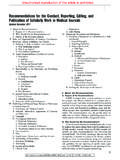Transcription of 6 June 18108 World Health Statistics 2018 - WHO
1 ISBN 978 92 4 156558 5201820182018 World Health Statistics 2018 : monitoring Health for the SDGs, sustainable development goalsISBN 978-92-4-156558-5 World Health Organization 2018 Some rights reserved. This work is available under the Creative Commons Attribution-NonCommercial-ShareAlike IGO licence (CC BY-NC-SA IGO; ). Under the terms of this licence, you may copy, redistribute and adapt the work for non-commercial purposes, provided the work is appropriately cited, as indicated below. In any use of this work, there should be no suggestion that WHO endorses any specific organization, products or services. The use of the WHO logo is not permitted. If you adapt the work, then you must license your work under the same or equivalent Creative Commons licence. If you create a translation of this work, you should add the following disclaimer along with the suggested citation: This translation was not created by the World Health Organization (WHO).
2 WHO is not responsible for the content or accuracy of this translation. The original English edition shall be the binding and authentic edition .Any mediation relating to disputes arising under the licence shall be conducted in accordance with the mediation rules of the World Intellectual Property citation. World Health Statistics 2018 : monitoring Health for the SDGs, sustainable development goals. Geneva: World Health Organization; 2018 . Licence: CC BY-NC-SA (CIP) data. CIP data are available at , rights and licensing. To purchase WHO publications, see To submit requests for commercial use and queries on rights and licensing, see materials. If you wish to reuse material from this work that is attributed to a third party, such as tables, figures or images, it is your responsibility to determine whether permission is needed for that reuse and to obtain permission from the copyright holder.
3 The risk of claims resulting from infringement of any third-party-owned component in the work rests solely with the disclaimers. The designations employed and the presentation of the material in this publication do not imply the expression of any opinion whatsoever on the part of WHO concerning the legal status of any country, territory, city or area or of its authorities, or concerning the delimitation of its frontiers or boundaries. Dotted and dashed lines on maps represent approximate border lines for which there may not yet be full agreement. The mention of specific companies or of certain manufacturers products does not imply that they are endorsed or recommended by WHO in preference to others of a similar nature that are not mentioned. Errors and omissions excepted, the names of proprietary products are distinguished by initial capital reasonable precautions have been taken by WHO to verify the information contained in this publication.
4 However, the published material is being distributed without warranty of any kind, either expressed or implied. The responsibility for the interpretation and use of the material lies with the reader. In no event shall WHO be liable for damages arising from its use. Photo credits: page v WHO; page vi (upper) Lubna A. Al-Ansary; page vi (lower) WHO/Christopher Black; page 1 WHO/Andrew Esiebo; page 4 WHO/Diego Rodriguez; page 13 WHO/Tom and layout by L IV Com S rl, Villars-sous-Yens, in ..vPreface ..viAbbreviations ..viiIntroduction ..viiiPart 1 Understanding data in the World Health Statistics series ..1 Part 2 Status of the Health -related SDGs .. Reproductive, maternal, newborn and child Health .. Infectious diseases .. Noncommunicable diseases and mental Health .. Injuries and violence .. Universal Health coverage and Health systems .. Environmental risks .. Health risks and disease outbreaks.
5 10 References ..11 Part 3A broad spectrum of Health challenges selected issues .. Increasing the coverage of essential Health services .. Cholera an underreported threat to progress .. Turning the rising tide of obesity in the young ..18 References ..21 Annex A: Summaries of selected Health -related SDG indicators ..22 Explanatory notes ..22 Indicator Maternal mortality ..23 Indicator Skilled birth attendance ..24 Indicators Child mortality ..25 Indicator HIV incidence ..26 Indicator Tuberculosis incidence ..27 Indicator Malaria incidence ..28 Indicator Hepatitis B incidence ..29 Indicator Need for neglected tropical disease interventions ..30 Indicator Mortality due to noncommunicable diseases ..31 Indicator Suicide mortality rate ..32 Indicator Alcohol use ..33 Indicator Deaths from road traffic injuries ..34 Indicator Family planning ..35 Indicator Adolescent birth rate.
6 36 Indicator Universal Health coverage: service coverage ..37 Indicator Universal Health coverage: financial protection ..38 Indicator Mortality due to air pollution ..39 CONTENTSiiiMONITORING Health FOR THE SDGsIndicator Mortality due to unsafe WASH services ..40 Indicator Mortality due to unintentional poisoning ..41 Indicator Tobacco Vaccine coverage ..43 Indicator Development assistance for Health ..44 Indicator Health workers ..45 Indicator IHR capacity and Health emergency preparedness ..46 Indicator Government spending on essential services, including Health ..47 Indicator Stunting among children ..48 Indicator Wasting and overweight among children ..49 Indicator Safely managed drinking-water services ..50 Indicator Safely managed sanitation services ..51 Indicator Clean household energy ..52 Indicator Air pollution ..53 Indicator Mortality due to disasters ..54 Indicator Homicide.
7 55 Indicator Mortality due to conflicts ..56 Indicator Death registration ..57 Annex B: Tables of Health -related SDG Statistics by country, WHO region and globally ..59 Explanatory notes ..59 Annex C: WHO regional groupings ..86ivWORLD Health Statistics : 2018 FOREWORDIn 2015, countries adopted the ambitious Sustainable Development Goals (SDGs), each of which has specific targets to be achieved over the next 15 years. The SDGs include one Health goal and over 50 Health -related targets which are applicable to all countries, irrespective of their level of development. It is essential that we track progress towards these targets in all countries a mammoth task in of the key roles of the World Health Organization (WHO) is to monitor global Health trends. The World Health Statistics series, published annually since 2005, is WHO s annual snapshot of the state of the World s Health . Since 2016, the World Health Statistics series has focused on monitoring progress towards the SDGs and this 2018 edition contains the latest available data for 36 Health -related SDG indicators.
8 The story it tells is that while we have made remarkable progress on several fronts, huge challenges remain if we are to reach the targets for Health we have set ourselves. In some areas progress has stalled and the gains we have made could easily be lost. Under-five mortality has improved dramatically yet each and every day in 2016, 15 000 children died before reaching their fifth birthday. After unprecedented global gains in malaria control, progress has stalled because of a range of challenges, including a lack of sustainable and predictable funding. And while the risk of dying from cardiovascular disease, chronic respiratory disease, diabetes or cancer has decreased since 2000, an estimated 13 million people under the age of 70 still died due to these diseases in 2016. Maintaining the momentum towards the SDGs is only possible if countries have the political will and the capacity to prioritize regular, timely and reliable data collection to guide policy decisions and public Health interventions.
9 I care about outcomes and about accountability and I want to ensure that WHO, together with our partners, is doing all we can to get countries on track to reach the WHO s 13th General Programme of Work is designed to do exactly that. At its heart are the ambitious triple billion targets: one billion more people benefitting from universal Health coverage (UHC); one billion more people better protected from Health emergencies; and one billion more people enjoying better Health and well-being. To keep ourselves accountable, we have developed an Impact Framework for the 13th General Programme of Work, aligned with the SDGs. This will allow us to measure the only progress that really matters: less death and disease, and more healthy living for everyone, Tedros Adhanom Ghebreyesus Director-GeneralWorld Health OrganizationvMONITORING Health FOR THE SDGsPREFACEW orld Health Statistics 2018 signals WHO s continued commitment to work with Member States and all partners to ensure WHO provides the most trusted Health -related data that are up to date, disaggregated and disseminated in an open manner, and widely used.
10 These data are an essential resource to achieve the Health -related SDGs and UHC. Robust Health metrics, improved and focused measurement, and use of evidence and research are high priorities in the WHO s 13th General Programme of Work. The Health Metrics and Measurement cluster works across WHO as the hub streamlining the flow of data from Member States and within the Organization, reducing the reporting burden on Member States, and coordinating research activities. For the first time in the World Health Statistics series, World Health Statistics 2018 provides labels to help users understand the types of data in the report. It also includes many updated data series as well as new indicators, and Part 3 is organized around WHO s new priority areas of work: UHC, Health emergencies, and healthier populations. Our ultimate goal is to support countries to make ethical and evidence-informed decisions to maximize Health gains for their populations.












